child seat HONDA CIVIC SEDAN 2021 Owner's Manual (in English)
[x] Cancel search | Manufacturer: HONDA, Model Year: 2021, Model line: CIVIC SEDAN, Model: HONDA CIVIC SEDAN 2021Pages: 632, PDF Size: 33.83 MB
Page 7 of 632
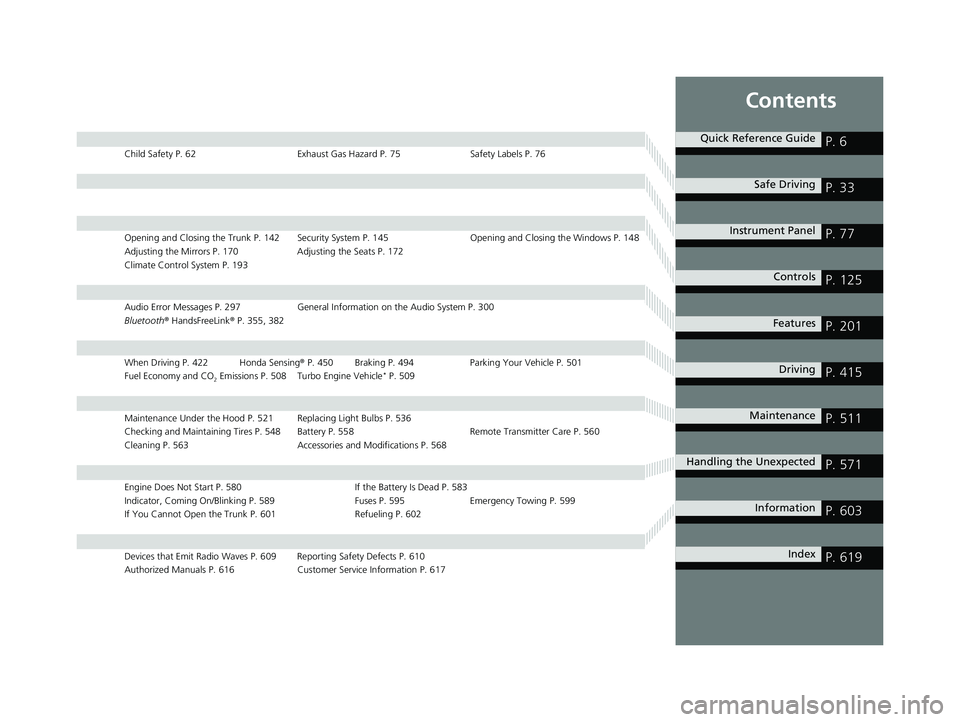
Contents
Child Safety P. 62Exhaust Gas Hazard P. 75Safety Labels P. 76
Opening and Closing the Trunk P. 142 Security System P. 145 Opening and Closing the Windows P. 148
Adjusting the Mirrors P. 170 Adjusting the Seats P. 172
Climate Control System P. 193
Audio Error Messages P. 297 General Information on the Audio System P. 300
Bluetooth ® HandsFreeLink ® P. 355, 382
When Driving P. 422 Honda Sensing ® P. 450 Braking P. 494 Parki ng Your Vehicle P. 501
Fuel Economy and CO
2 Emissions P. 508 Turbo Engine Vehicle* P. 509
Maintenance Under the Hood P. 521 Replacing Light Bulbs P. 536
Checking and Maintaining Tires P. 548 Battery P. 558 Remote Transmitter Care P. 560
Cleaning P. 563 Accessories and Modifications P. 568
Engine Does Not Start P. 580 If the Battery Is Dead P. 583
Indicator, Coming On/Blinking P. 589 Fuses P. 595Emergency Towing P. 599
If You Cannot Open the Trunk P. 601 Refueling P. 602
Devices that Emit Radio Waves P. 609 Reporting Safety Defects P. 610
Authorized Manuals P. 616 Customer Service Information P. 617
Quick Reference GuideP. 6
Safe DrivingP. 33
Instrument PanelP. 77
ControlsP. 125
FeaturesP. 201
DrivingP. 415
MaintenanceP. 511
Handling the UnexpectedP. 571
InformationP. 603
IndexP. 619
21 CIVIC 4D HCM_HMIN_J (KA KL KC)-31TBA6500.book 5 ページ 2020年8月25日 火曜日 午後2時6分
Page 11 of 632
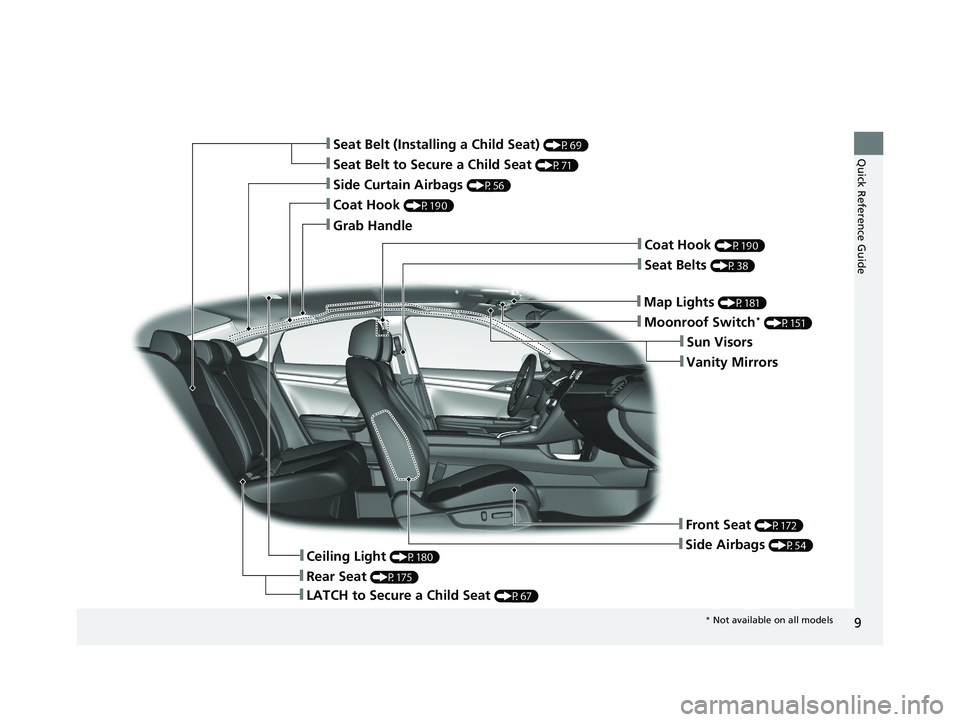
9
Quick Reference Guide❚Seat Belt to Secure a Child Seat (P71)
❚Seat Belt (Installing a Child Seat) (P69)
❚Moonroof Switch* (P151)
❚Front Seat (P172)
❚Seat Belts (P38)
❚Side Airbags (P54)
❚Rear Seat (P175)
❚LATCH to Secure a Child Seat (P67)
❚Ceiling Light (P180)
❚Side Curtain Airbags (P56)
❚Coat Hook (P190)
❚Grab Handle
❚Coat Hook (P190)
❚Sun Visors
❚Vanity Mirrors
❚Map Lights (P181)
* Not available on all models
21 CIVIC 4D HCM_HMIN_J (KA KL KC)-31TBA6500.book 9 ページ 2020年8月25日 火曜日 午後2時6分
Page 14 of 632
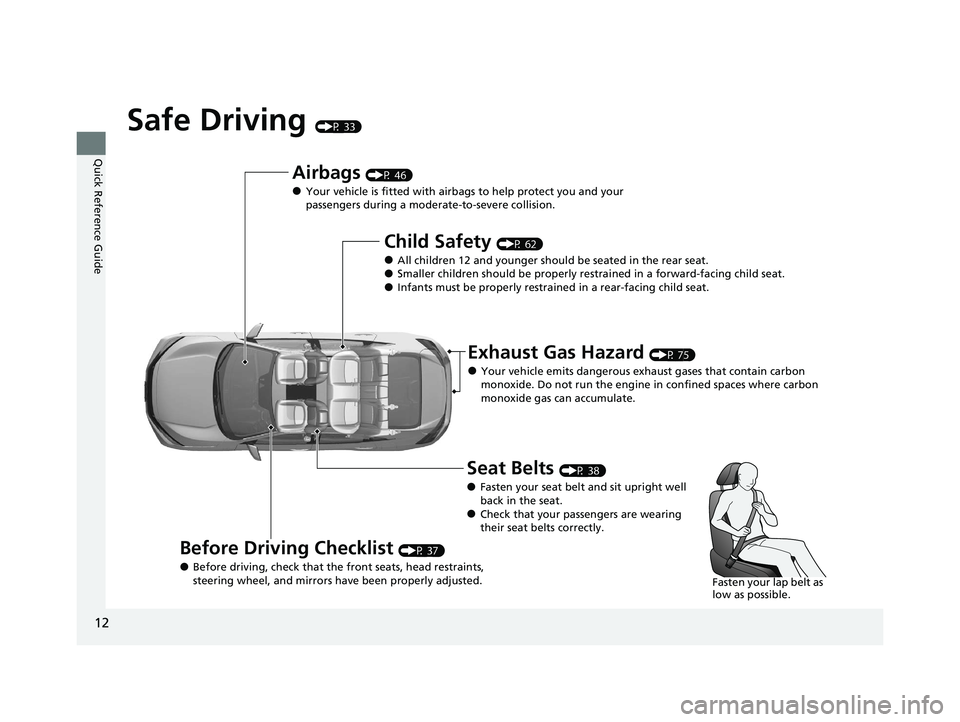
12
Quick Reference Guide
Safe Driving (P 33)
Airbags (P 46)
●Your vehicle is fitted with airbags to help protect you and your
passengers during a moderate-to-severe collision.
Child Safety (P 62)
●All children 12 and younger should be seated in the rear seat.●Smaller children should be properly restrained in a forward-facing child seat.●Infants must be properly restrained in a rear-facing child seat.
Exhaust Gas Hazard (P 75)
●Your vehicle emits dangerous exhaust gases that contain carbon
monoxide. Do not run the engine in confined spaces where carbon
monoxide gas can accumulate.
Before Driving Checklist (P 37)
●Before driving, check that the front seats, head restraints,
steering wheel, and mirrors have been properly adjusted.
Seat Belts (P 38)
●Fasten your seat belt and sit upright well
back in the seat.
●Check that your passengers are wearing
their seat belts correctly.
Fasten your lap belt as
low as possible.
21 CIVIC 4D HCM_HMIN_J (KA KL KC)-31TBA6500.book 12 ページ 2020年8月25日 火曜日 午後2時6分
Page 35 of 632
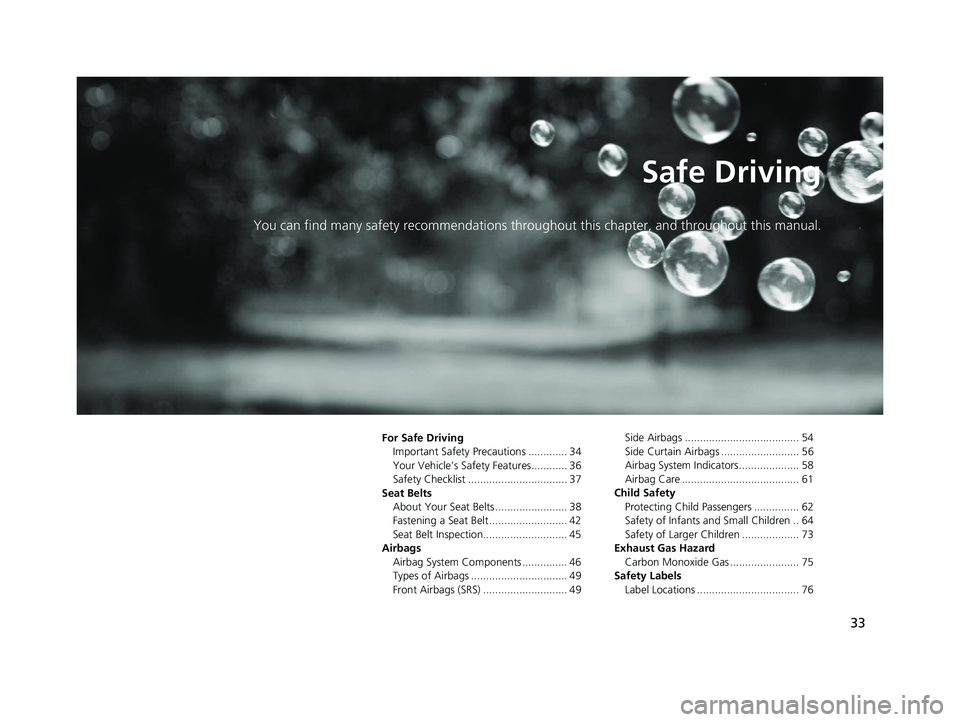
33
Safe Driving
You can find many safety recommendations throughout this chapter, and throughout this manual.
For Safe Driving
Important Safety Precautions ............. 34
Your Vehicle’s Safety Features............ 36
Safety Checklist ................................. 37
Seat Belts About Your Seat Belts ........................ 38
Fastening a Seat Belt .......................... 42
Seat Belt Inspection............................ 45
Airbags Airbag System Components ............... 46
Types of Airbags ................................ 49
Front Airbags (SRS) ............................ 49 Side Airbags ...................................... 54
Side Curtain Airbags .......................... 56
Airbag System Indicators.................... 58
Airbag Care ....................................... 61
Child Safety Protecting Child Passengers ............... 62
Safety of Infants a nd Small Children .. 64
Safety of Larger Children ................... 73
Exhaust Gas Hazard Carbon Monoxide Gas ....................... 75
Safety Labels Label Locations .................................. 76
21 CIVIC 4D HCM_HMIN_J (KA KL KC)-31TBA6500.book 33 ページ 2020年8月25日 火曜日 午後2時6分
Page 36 of 632
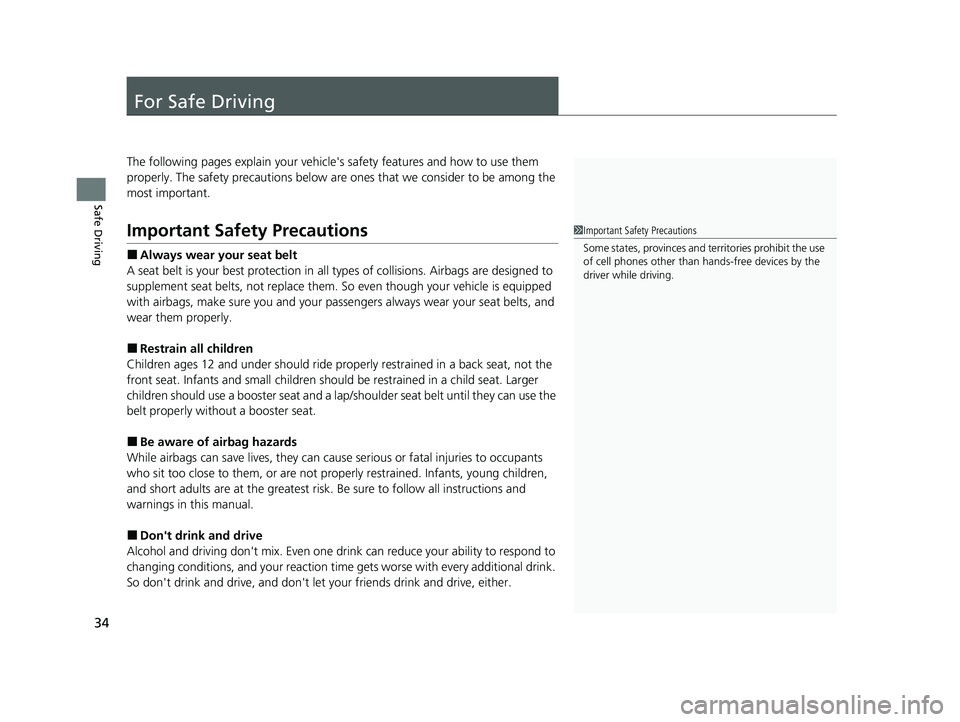
34
Safe Driving
For Safe Driving
The following pages explain your vehicle's safety features and how to use them
properly. The safety precautions below are ones that we consider to be among the
most important.
Important Safety Precautions
■Always wear your seat belt
A seat belt is your best protection in all types of collisions. Airbags are designed to
supplement seat belts, not replace them. So even though your vehicle is equipped
with airbags, make sure you and your passengers always wear your seat belts, and
wear them properly.
■Restrain all children
Children ages 12 and under should ride prop erly restrained in a back seat, not the
front seat. Infants and small children should be restrained in a child seat. Larger
children should use a booster seat and a lap/shoulder seat belt until they can use the
belt properly without a booster seat.
■Be aware of airbag hazards
While airbags can save lives, they can cause serious or fatal injuries to occupants
who sit too close to them, or are not prop erly restrained. Infants, young children,
and short adults are at the greatest risk. Be sure to follow all instructions and
warnings in this manual.
■Don't drink and drive
Alcohol and driving don't mix. Even one dr ink can reduce your ability to respond to
changing conditions, and your reaction time gets worse with every additional drink.
So don't drink and drive, and don't let your friends drink and drive, either.
1Important Safety Precautions
Some states, provinces and te rritories prohibit the use
of cell phones other than hands-free devices by the
driver while driving.
21 CIVIC 4D HCM_HMIN_J (KA KL KC)-31TBA6500.book 34 ページ 2020年8月25日 火曜日 午後2時6分
Page 39 of 632
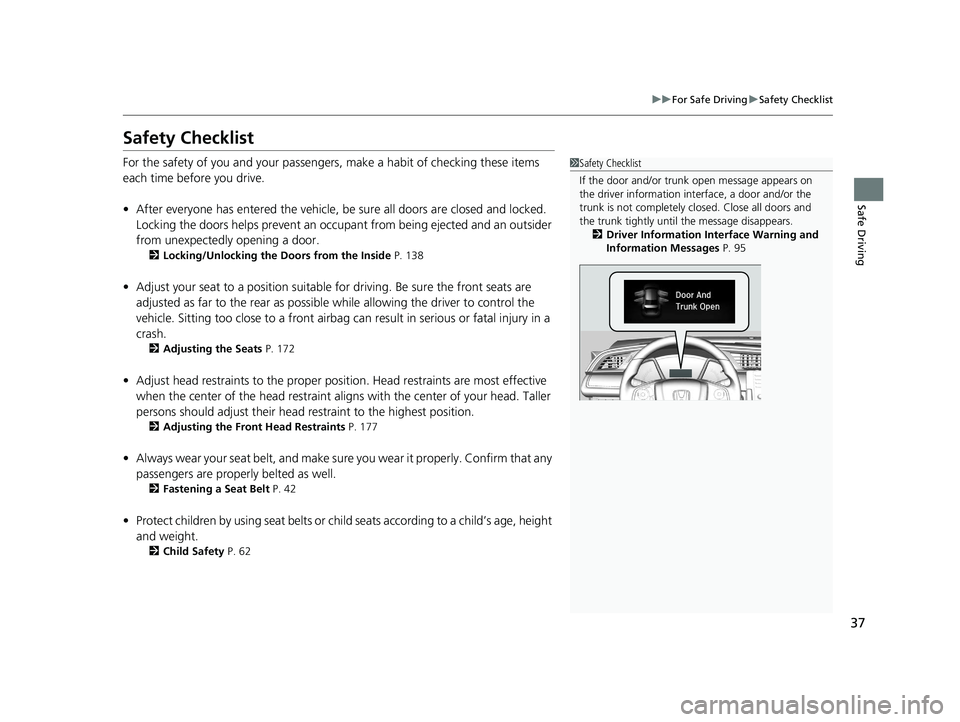
37
uuFor Safe Driving uSafety Checklist
Safe Driving
Safety Checklist
For the safety of you and your passengers, make a habit of checking these items
each time before you drive.
• After everyone has entered the vehicle, be sure all doors are closed and locked.
Locking the doors helps prevent an occupant from being ejected and an outsider
from unexpectedly opening a door.
2 Locking/Unlocking the Doors from the Inside P. 138
•Adjust your seat to a position suitable for driving. Be sure the front seats are
adjusted as far to the rear as possible while allowing the driver to control the
vehicle. Sitting too close to a front airbag can result in serious or fatal injury in a
crash.
2 Adjusting the Seats P. 172
•Adjust head restraints to the proper position. Head restraints are most effective
when the center of the head restraint alig ns with the center of your head. Taller
persons should adjust their head restraint to the highest position.
2Adjusting the Front Head Restraints P. 177
•Always wear your seat belt, and make sure you wear it properly. Confirm that any
passengers are properly belted as well.
2 Fastening a Seat Belt P. 42
•Protect children by using seat belts or child seats according to a child’s age, height
and weight.
2 Child Safety P. 62
1Safety Checklist
If the door and/or trunk open message appears on
the driver information inte rface, a door and/or the
trunk is not completely cl osed. Close all doors and
the trunk tightly until the message disappears.
2 Driver Information Interface Warning and
Information Messages P. 95
21 CIVIC 4D HCM_HMIN_J (KA KL KC)-31TBA6500.book 37 ページ 2020年8月25日 火曜日 午後2時6分
Page 40 of 632
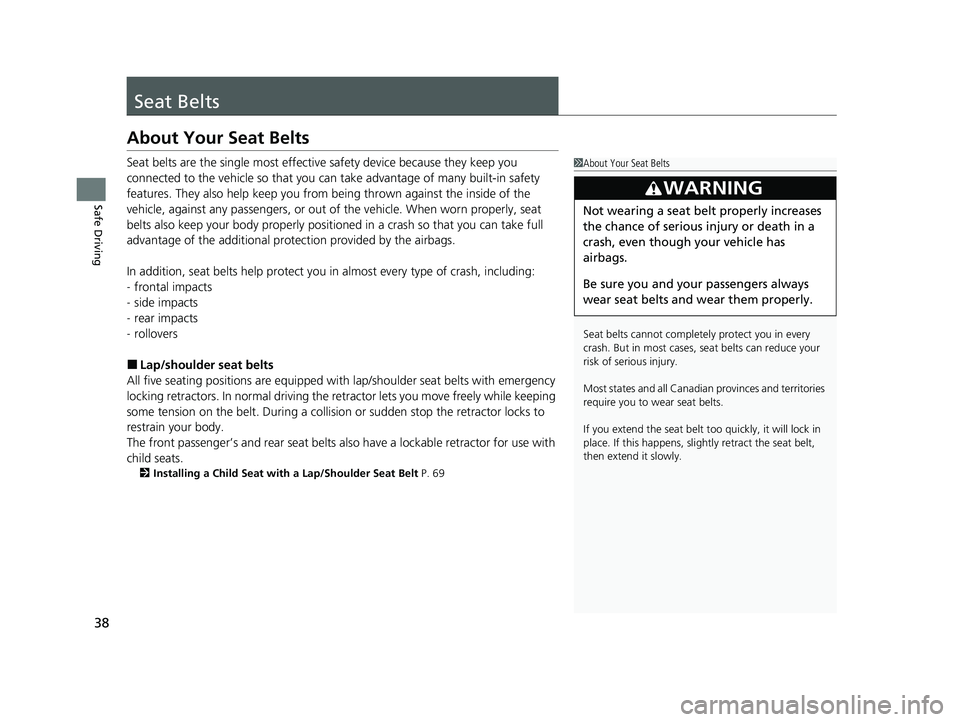
38
Safe Driving
Seat Belts
About Your Seat Belts
Seat belts are the single most effective safety device because they keep you
connected to the vehicle so that you can take advantage of many built-in safety
features. They also help keep you from being thrown against the inside of the
vehicle, against any passenger s, or out of the vehicle. When worn properly, seat
belts also keep your body properly positi oned in a crash so that you can take full
advantage of the additional prot ection provided by the airbags.
In addition, seat belts help protect you in almost every type of crash, including:
- frontal impacts
- side impacts
- rear impacts
- rollovers
■Lap/shoulder seat belts
All five seating positions are equipped with lap/shoulder seat belts with emergency
locking retractors. In normal driving the retractor lets you move freely while keeping
some tension on the belt. During a collis ion or sudden stop the retractor locks to
restrain your body.
The front passenger’s and rear seat belts al so have a lockable retractor for use with
child seats.
2 Installing a Child Seat with a Lap/Shoulder Seat Belt P. 69
1About Your Seat Belts
Seat belts cannot complete ly protect you in every
crash. But in most cases, seat belts can reduce your
risk of serious injury.
Most states and all Canadian provinces and territories
require you to wear seat belts.
If you extend the seat belt t oo quickly, it will lock in
place. If this happens, sli ghtly retract the seat belt,
then extend it slowly.
3WARNING
Not wearing a seat belt properly increases
the chance of serious injury or death in a
crash, even though your vehicle has
airbags.
Be sure you and your passengers always
wear seat belts and wear them properly.
21 CIVIC 4D HCM_HMIN_J (KA KL KC)-31TBA6500.book 38 ページ 2020年8月25日 火曜日 午後2時6分
Page 42 of 632
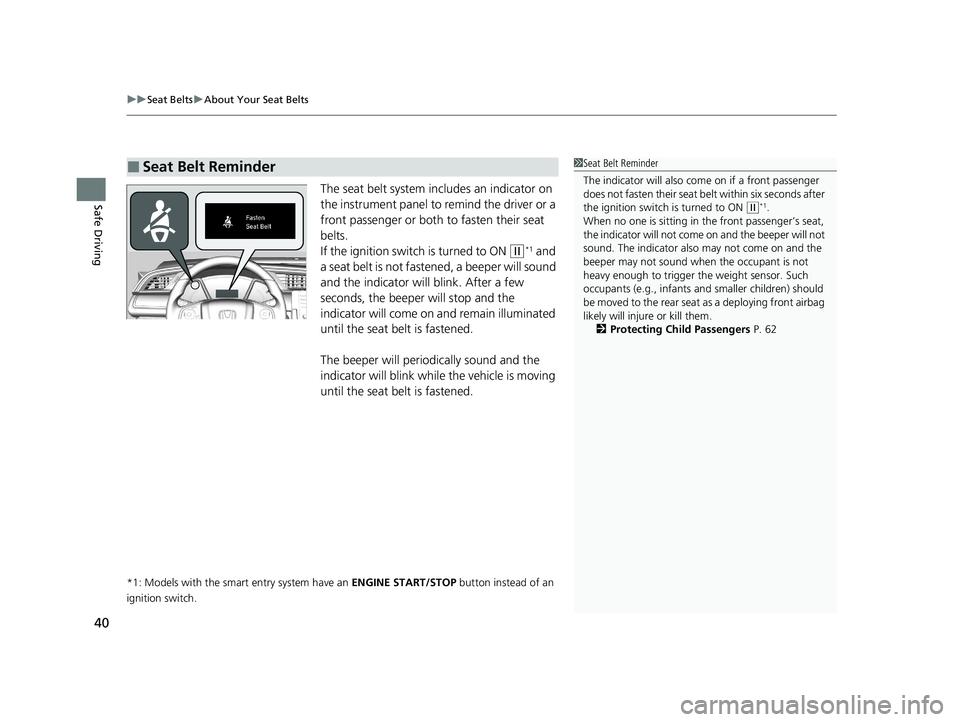
uuSeat Belts uAbout Your Seat Belts
40
Safe DrivingThe seat belt system in cludes an indicator on
the instrument panel to remind the driver or a
front passenger or both to fasten their seat
belts.
If the ignition switch is turned to ON
(w*1 and
a seat belt is not fastened, a beeper will sound
and the indicator will blink. After a few
seconds, the beeper will stop and the
indicator will come on and remain illuminated
until the seat belt is fastened.
The beeper will periodically sound and the
indicator will blink while the vehicle is moving
until the seat belt is fastened.
*1: Models with the smart entry system have an ENGINE START/STOP button instead of an
ignition switch.
■Seat Belt Reminder1 Seat Belt Reminder
The indicator will also co me on if a front passenger
does not fasten their seat be lt within six seconds after
the ignition switch is turned to ON
( w*1.
When no one is sitting in th e front passenger’s seat,
the indicator will not come on and the beeper will not
sound. The indicator also may not come on and the
beeper may not sound when the occupant is not
heavy enough to trigger th e weight sensor. Such
occupants (e.g., infants and smaller children) should
be moved to the rear seat as a deploying front airbag
likely will injure or kill them.
2 Protecting Child Passengers P. 62
21 CIVIC 4D HCM_HMIN_J (KA KL KC)-31TBA6500.book 40 ページ 2020年8月25日 火曜日 午後2時6分
Page 46 of 632
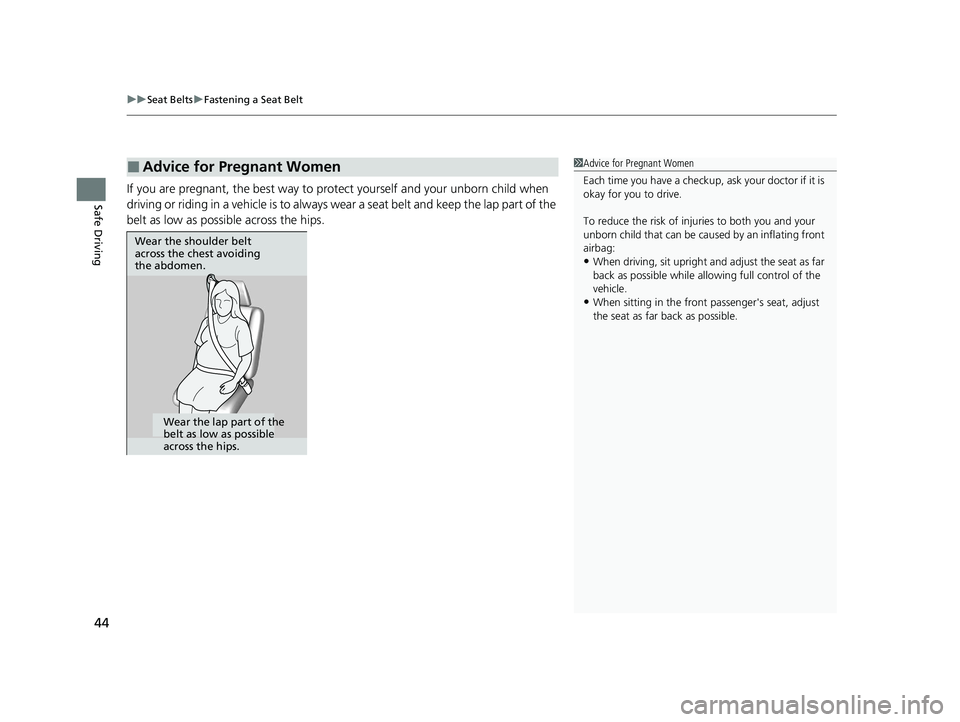
uuSeat Belts uFastening a Seat Belt
44
Safe DrivingIf you are pregnant, the best way to protect yourself and your unborn child when
driving or riding in a vehicle is to always wear a seat belt and keep the lap part of the
belt as low as possi ble across the hips.
■Advice for Pregnant Women1Advice for Pregnant Women
Each time you have a checkup, ask your doctor if it is
okay for you to drive.
To reduce the risk of inju ries to both you and your
unborn child that can be caus ed by an inflating front
airbag:
•When driving, sit upright a nd adjust the seat as far
back as possible while allowing full control of the
vehicle.
•When sitting in the front passenger's seat, adjust
the seat as far back as possible.
Wear the shoulder belt
across the chest avoiding
the abdomen.
Wear the lap part of the
belt as low as possible
across the hips.
21 CIVIC 4D HCM_HMIN_J (KA KL KC)-31TBA6500.book 44 ページ 2020年8月25日 火曜日 午後2時6分
Page 54 of 632
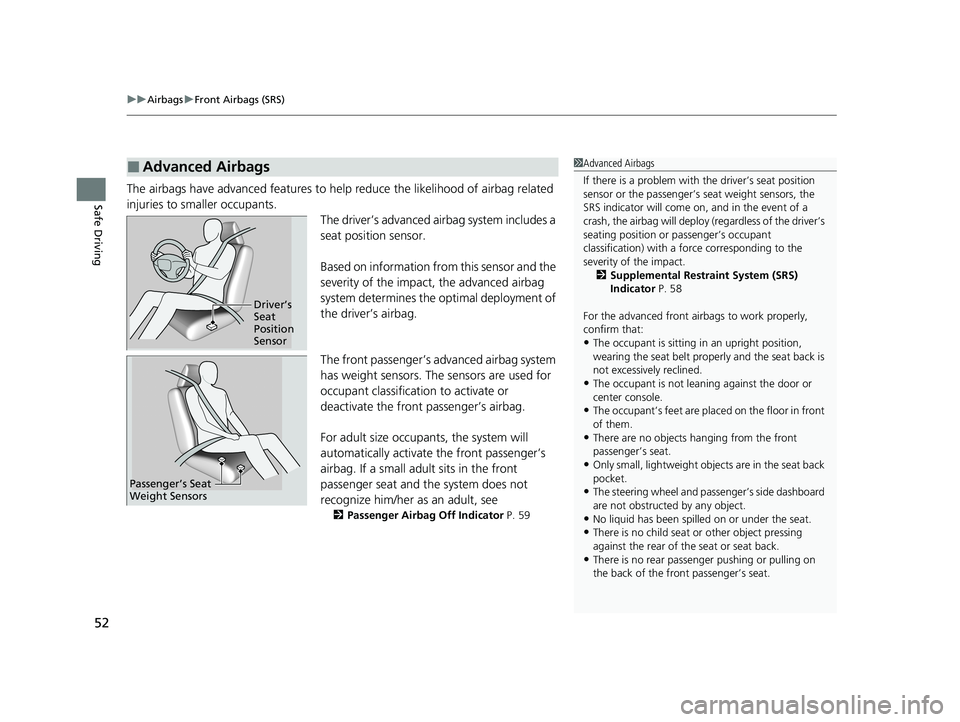
uuAirbags uFront Airbags (SRS)
52
Safe DrivingThe airbags have advanced features to help reduce the likelihood of airbag related
injuries to smaller occupants.
The driver’s advanced airbag system includes a
seat position sensor.
Based on information from this sensor and the
severity of the impact, the advanced airbag
system determines the optimal deployment of
the driver’s airbag.
The front passenger’s advanced airbag system
has weight sensors. The sensors are used for
occupant classification to activate or
deactivate the front passenger’s airbag.
For adult size occupants, the system will
automatically activate the front passenger’s
airbag. If a small adul t sits in the front
passenger seat and the system does not
recognize him/her as an adult, see
2 Passenger Airbag Off Indicator P. 59
■Advanced Airbags1Advanced Airbags
If there is a problem with the driver’s seat position
sensor or the passenger’s s eat weight sensors, the
SRS indicator will come on, and in the event of a
crash, the airbag will deploy (regardless of the driver’s
seating position or passenger’s occupant
classification) with a force corresponding to the
severity of the impact. 2 Supplemental Restraint System (SRS)
Indicator P. 58
For the advanced front airbags to work properly,
confirm that:
•The occupant is sitting in an upright position,
wearing the seat belt prope rly and the seat back is
not excessively reclined.
•The occupant is not leaning against the door or
center console.
•The occupant’s feet are plac ed on the floor in front
of them.
•There are no objects ha nging from the front
passenger’s seat.
•Only small, lightweight objec ts are in the seat back
pocket.
•The steering wheel and passenger’s side dashboard
are not obstructed by any object.
•No liquid has been spille d on or under the seat.•There is no child seat or other object pressing
against the rear of the seat or seat back.
•There is no rear passenger pushing or pulling on
the back of the front passenger’s seat.
Driver’s
Seat
Position
Sensor
Passenger’s Seat
Weight Sensors
21 CIVIC 4D HCM_HMIN_J (KA KL KC)-31TBA6500.book 52 ページ 2020年8月25日 火曜日 午後2時6分